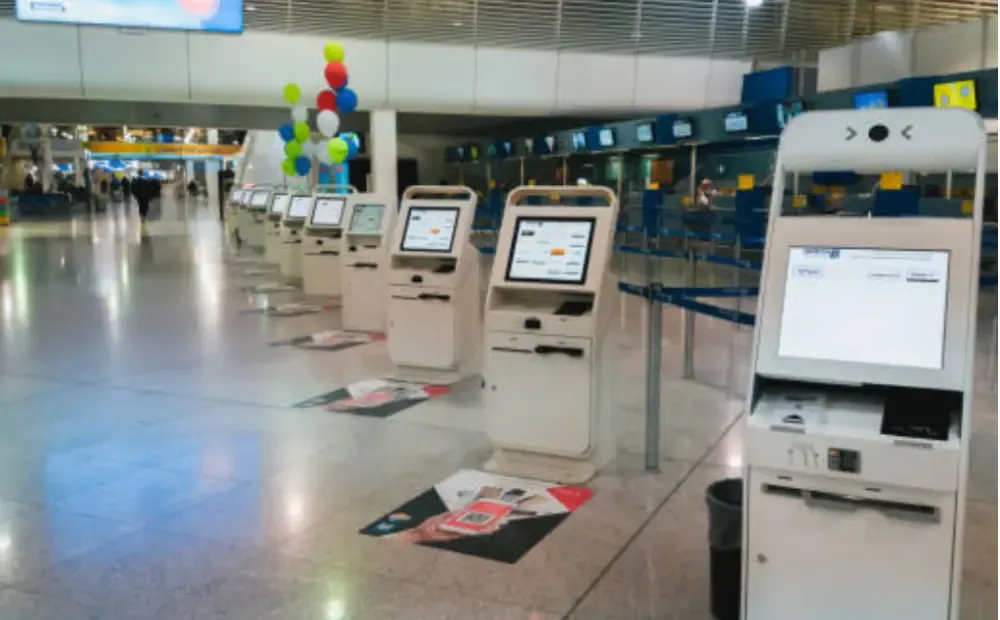Airports rely on self-check-in kiosks to keep travelers moving. No lines. No delays. Just a touchscreen and a few taps. These kiosk machines changed how people check in, especially as demand for contactless travel spiked. Now you see airport self-check-in kiosks everywhere…at entrances, terminals, even near gates.
This article explains how a check-in kiosk works, how to use one, and the tech that makes it possible. Whether you’re flying or planning airport systems, this guide explains it all.
What Is an Airport Self-Check-In Kiosk and Why Does It Matter
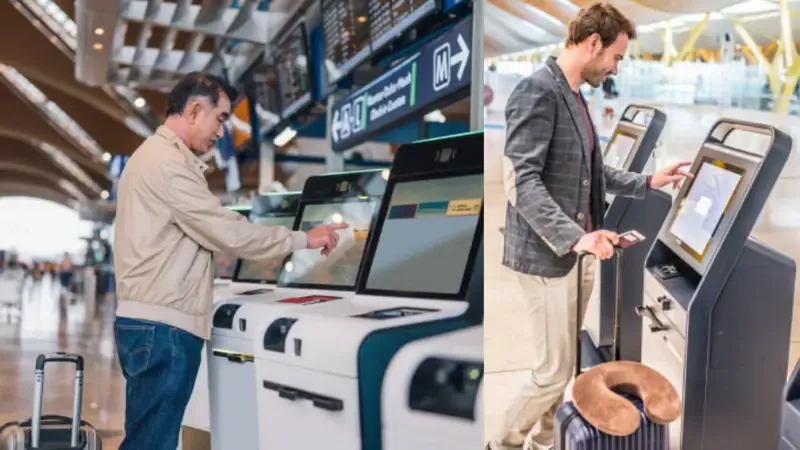
An airport self-check-in kiosk is a digital terminal. It lets passengers check in for their flights without airline staff.
These machines are placed inside airport terminals. They allow travelers to confirm flight details, choose seats, and print boarding passes.
Most use a touchscreen and identity verification. Some also scan passports and print baggage tags.
These Service Kiosk Are a Necessity for Airports
Airports use these kiosks to move people faster through check-in zones. They also help reduce staffing needs.
The kiosks are part of a larger self-service network that connects with airline and airport systems in real time. They’re flexible, too. Airport operators can update the software or add new airline integrations remotely.
This makes kiosk machines a core tool in any modern airport self-check-in system.
The Evaluation From Manned Counters to Self-Service Systems
Airports once relied entirely on manned counters to handle check-ins.
This approach led to long lines, bottlenecks, and high staffing costs. The self-check-in kiosk changed that.
Now, a single row of kiosks can process hundreds of passengers each hour.
Staff no longer need to handle routine tasks. They can focus on solving problems or helping high-priority cases. This change also improved consistency.
A kiosk won’t skip a step or misread a boarding zone. It follows a fixed process every time, reducing the margin for human error.
Step-by-Step: How to Use a Self-Check-In Kiosk at the Airport

Most modern airports now have check-in kiosks lined up across the terminal entrance or near the airline counters.
They’re easy to use if you know what to expect. This section walks you through the entire kiosk check-in process, from start to finish.
1. Start Screen and Language Selection
As you walk up to the self-check-in kiosk, you’ll first see a welcome screen. Tap to begin and choose your preferred language. Most systems support multiple languages to assist international travelers.
2. Confirm Identity
You’ll need to verify your booking. The kiosk may ask for one of the following:
- Passport scan (most common for international flights)
- Booking reference number or confirmation code
- Credit card used to book the ticket (used for identity only, not for charges)
- Airline loyalty card or frequent flyer number
- Mobile check-in QR code (scanned directly from your phone)
Some advanced kiosks now support facial recognition to pull up booking info instantly.
3. Review Flight Info and Select a Seat
Once your identity is verified, the kiosk will show your flight details. You can then:
- Confirm your itinerary
- Select or change your seat
- Add any optional services (depending on the airline)
For group bookings, some kiosks allow check-in for multiple passengers at once.
4. Add Checked Baggage (If Needed)
If you have bags to check, follow the on-screen prompts to add them. You may be asked to:
- Indicate how many bags you’re checking
- Pay for baggage if your fare doesn’t include it (card payment at the kiosk)
- Weigh your luggage at a separate bag-drop scale nearby
5. The kiosk will print your boarding pass and bag tags
After confirming your details, the kiosk prints your boarding pass. If you added baggage, it will also print bag tags. Follow the instructions on the screen to attach the tag correctly to your luggage. Most kiosks show a clear diagram to help with this.
6. Head to the bag drop counter or go straight to security
If you checked in baggage, take your tagged luggage to the designated bag drop counter nearby. If you’re traveling with carry-on only, you can proceed directly to security screening with your boarding pass and ID in hand.
How Airport Self-Check-In Kiosks Improve Efficiency for Travelers, Airlines, and Airports

Self-check-in kiosks solve specific problems for everyone involved in airport operations. They reduce wait times and ease staffing pressure. These systems offer clear and measurable benefits.
Below, we’ve broken down the core benefits based on who’s using…or relying on them most.
For Travelers ( Less Waiting, More Control)
When you’re running late or the airport is packed, waiting in line can feel like a waste of time. Self-check-in kiosks give travelers more control over the check-in process. They also reduce the need to rely on airline counters.
- Skip the counter entirely and check in within minutes
- Choose your seat and print your boarding pass without needing help
- Use multilingual interfaces that support straightforward navigation for international passengers
- Reduce last-minute stress, especially during early morning or tight layover flights.
These kiosks cut the average check-in time by more than 50%. They help travelers move through the terminal faster and with less frustration..
For Airlines (Lower Costs, Faster Throughput)
Airlines handle thousands of passengers a day, and every second saved counts. Kiosks help streamline operations and reduce the need for front-desk staff.
- Automate repetitive tasks like boarding pass printing and seat selection
- Reassign staff to high-touch areas like boarding gates or passenger support
- Handle more passengers per hour during flight delays or reschedules
- Offer a standardized, error-free check-in process across multiple locations
According to Wavetech, over 70% of passengers prefer using self-service kiosks when given the option. This reduces pressure on staffed counters during peak periods.
For Airports (Smarter Flow and Scalable Infrastructure)
Terminals are constantly evolving. With growing passenger volumes and security layers, airport layouts need flexible, reliable systems. Self-check-in kiosks fill that need.
- Reduce congestion at check-in halls without adding floor space
- Scale kiosk numbers seasonally or by airline contract
- Pull real-time data on passenger flow and kiosk performance
- Integrate kiosks into larger digital check-in and biometric systems
Upgrading to kiosk-driven check-in helps airports future-proof their infrastructure. They can do this without major construction or large staffing investments.
Types of Airport Kiosks and Their Use Cases
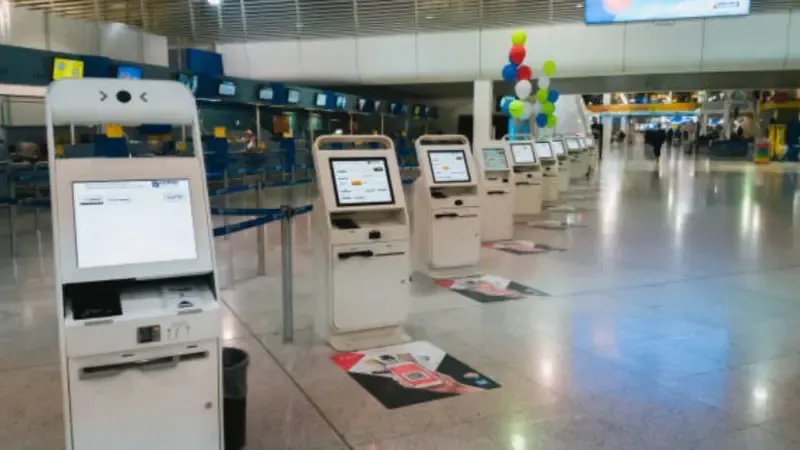
Airports use different kiosk machines to handle specific tasks across the passenger journey. The type of kiosk deployed depends on airline workflows, space availability, and passenger needs.
Understanding these categories helps airport teams and vendors plan better integrations within the terminal.
Ticketing Kiosks
These are the most common self-service kiosks. You’ll find them near terminal entrances or airline check-in areas. They let passengers confirm bookings, choose seats, and print boarding passes—without staff.
Most ticketing kiosks include a touchscreen, a passport scanner, and a boarding pass printer.
They handle travelers quickly, especially those without checked bags. This eases counter pressure for airlines during busy times.
Systems like NCR’s SelfServ and SITA’s CUSS kiosks are common at international airports..
Bag Drop Kiosks
Bag drop kiosks are for passengers who’ve already checked in. They let travelers tag and submit their luggage without staff help. These kiosks are usually placed near conveyor belts or in dedicated bag-drop lanes.
Passengers scan their boarding passes.
The kiosk then prints the baggage tag and applies it. They place the tagged baggage on the conveyor belt. Some models have built-in weighing scales. Others connect directly to the baggage handling system.
Bag drop kiosks help reduce wait times at full-service counters. They also keep luggage moving smoothly during peak hours.
Biometric Kiosks
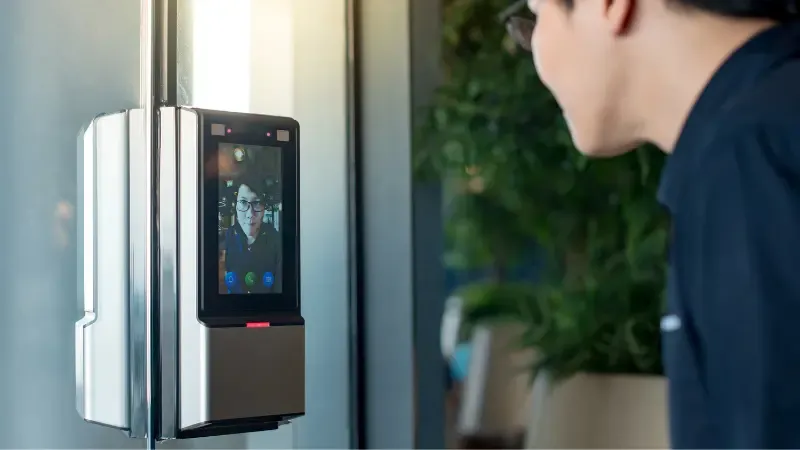
Biometric-enabled kiosks use facial recognition or fingerprint scanning to verify identity.
They are often placed in areas that require secure ID checks. This includes international check-in, boarding gates, and immigration points.
The kiosk matches biometric data with the passenger’s passport or travel record stored in the system.
Examples include SITA Smart Path and Vision-Box solutions. These kiosks reduce repeated manual ID checks.
They keep the passenger flow fast without compromising security..
Hybrid Kiosks
Hybrid kiosks combine several functions in one unit. They handle check-in, payment, bag tagging, and document scanning.
These kiosks are usually installed in high-traffic areas or premium check-in zones. Hybrib kiosks are ideal for compact terminals with limited counter space.
They’re designed for full passenger handling from start to finish. This reduces the need to visit multiple stations.
Each self-service system plays a role in improving airport operations.
They support scalable, tech-driven airport solutions. When placed strategically, they improve terminal flow.
They also reduce staffing needs and enhance the passenger experience from curb to gate.
The Technology Powering Airport Self-Check-In Kiosks
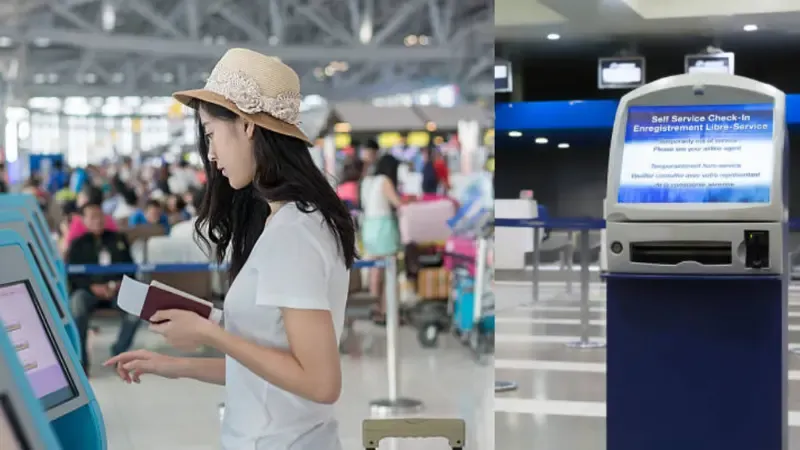
Self-check-in kiosks rely on a mix of hardware, software, and real-time integrations.
These parts work together to deliver consistent performance. Whether you’re expanding terminal infrastructure or just curious, here’s a look at what powers these systems behind the scenes.
Core Hardware Components
A typical airport kiosk has all the key hardware passengers need to check in and get things done easily:
- Touchscreen display: Used for navigation, language selection, and check-in steps.
- Passport and ID scanner: Captures passport or national ID data for identity verification.
- Boarding pass printer: Outputs printed boarding passes for passengers.
- Bag tag printer: Prints tags for checked luggage when baggage is added.
Most hardware units are housed in tamper-resistant frames and built to run nonstop under high foot traffic.
Software and System Integrations
What keeps airport kiosks running smoothly is the software that connects them to airline and airport systems. Here’s how it works:
- Airline check-in system integrations: Real-time access to bookings, seating, and baggage rules.
- Cloud-based content and user flow management: Allows airport teams to update kiosk UX and logic remotely.
- Custom UX interfaces: Designed for fast completion, low error rates, and easy multilingual switching.
The software is often vendor-specific but built on standard communication protocols to ensure compatibility across multiple carriers.
Advanced Add-Ons and Features
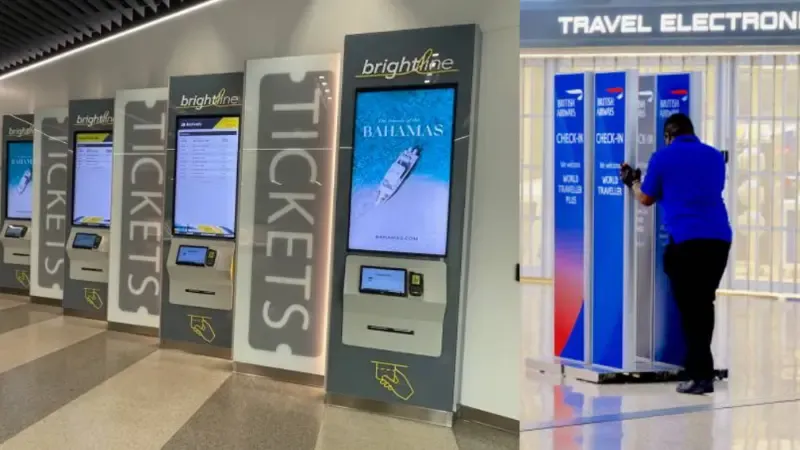
Modern airport tech demands more than just the basics. Today’s kiosks often include additional technologies like:
- Biometric modules: Face or fingerprint scan for faster identity matching
- RFID readers: For scanning loyalty cards or biometric-enabled passports
- NFC support: Allows mobile boarding pass or digital ID scans
These tools reduce the need for manual verification. And support seamless hand-offs to other airport systems, like boarding gates or immigration control.
Technology Trends and Innovations
Several upgrades are shaping the future of digital check-in:
- AI-powered personalization: Kiosks that adjust language or display based on passenger profile
- Voice-enabled interface: For travelers with limited mobility or visual impairments
- Expanded language support: Including regional dialects and right-to-left scripts
These features improve accessibility and reduce friction for international or first-time travelers.
System Reliability and Fail-Safe Protocols
Reliability is critical in high-volume airport environments. Modern kiosks connect to real-time data from airline servers.
They use backend redundancy to stay operational during server outages or busy periods.
If one kiosk fails, others keep working without data loss or needing passengers to start over. For IT teams, uptime monitoring and remote error diagnostics are standard features.
These kiosks are often monitored 24/7 through centralized dashboards. The dashboards are integrated into the airport’s wider digital infrastructure.
Limitations and Challenges of Self-Check-In Kiosks
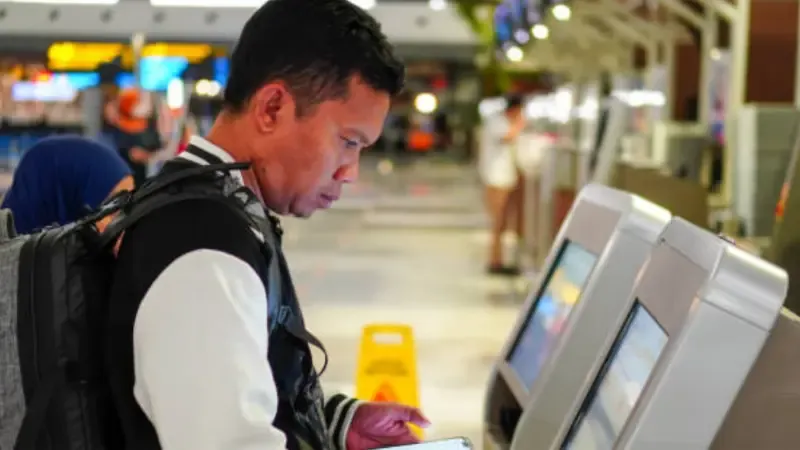
While self-check-in kiosks improve efficiency, they also come with operational and user-facing challenges.
Recognizing these limitations helps airports and airlines design better support systems and reduce points of failure.
Usability Gaps for Certain Passenger Groups
Not all travelers find kiosks easy to use. For some, the interface itself becomes a barrier.
- Elderly travelers may struggle with touchscreen speed, text size, or unfamiliar steps.
- Language limitations in some kiosks make it difficult for non-native speakers to complete the process.
- First-time flyers may hesitate to use machines without visible staff nearby.
Technical Issues That Disrupt Flow
Hardware and software glitches can stall even the best-designed systems.
- Printer jams delay boarding pass or bag tag printing.
- ID verification errors occur if passports are worn, scanned poorly, or mismatched.
- System lag or unresponsive touchscreens can create frustration and slow down lines.
These are common self-check-in kiosk issues, especially during peak traffic when systems are under load.
Security and Data Privacy Concerns
Unattended kiosks must handle sensitive information responsibly.
- Passenger data (passport, booking info) needs to be encrypted and cleared after each session.
- Unattended access risks arise when a user walks away mid-check-in without logging out.
Airports often mitigate this with automatic timeouts, encrypted connections, and physical oversight.
Over-Reliance and Downtime Risks
Fewer staffed counters mean that any kiosk-wide failure could create long delays. If multiple machines go offline, passengers may have no backup unless manual counters are restored.
How Airports Address These Issues
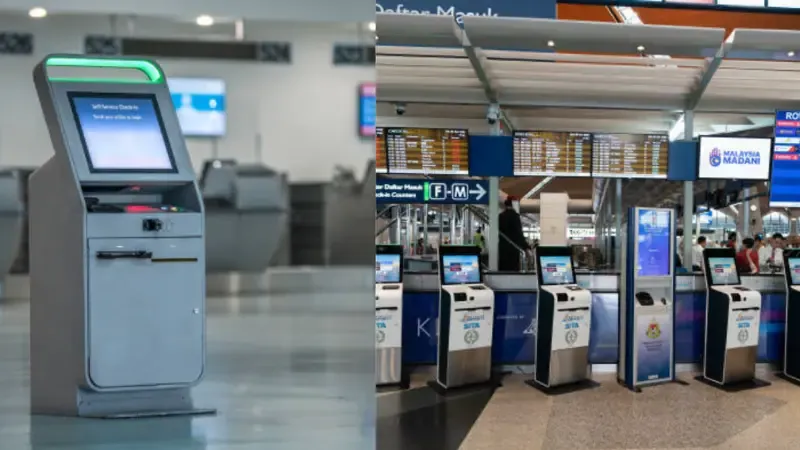
To keep things running, most airports implement:
- On-site support staff stationed near kiosks to assist or troubleshoot
- Biometric failsafes for quick identity verification when manual scanning fails
- Remote monitoring systems to track kiosk uptime and flag malfunctions in real time
These safety nets help reduce pressure on travelers and minimize downtime during technical problems.
FAQs About Airport Self-Check-in Kiosk
What is the difference between a self-check-in kiosk and a traditional counter?
A self-check-in kiosk is fully automated. You confirm your booking, select a seat, and print documents without airline staff. Traditional counters require interaction with an agent for the same tasks.
Are self-check-in kiosks available at all airports?
No, not all airports have them. Larger international and regional hubs typically offer self-check-in kiosks, but smaller airports may still rely on staffed counters for check-in.
Can I check in baggage using a self-check-in kiosk?
Yes. Most kiosks let you add checked bags and print bag tags. After tagging your luggage, you drop it off at a designated bag-drop counter nearby.
Is it safe to use a self-check-in kiosk?
Yes, airport kiosks use encrypted systems and clear data after each session. Avoid leaving your personal information on-screen, and always collect your documents before walking away.
What if I make a mistake during kiosk check-in?
You can cancel and restart the session. If you’ve already printed documents or need help, airport staff are usually stationed nearby to assist or correct the issue.
Can I use a kiosk if I’m flying internationally?
Yes. Most international airlines support kiosk check-in, though you’ll still need to verify your travel documents at the gate or a staffed counter in some countries.
Final Take: Kiosks as the Backbone of Smarter Airports
Self-check-in kiosks are a necessity for airlines. They’re the default entry point to digital air travel. Their real value lies in what they unlock. They enable smarter routing, faster boarding, and fewer interruptions.
Airports that invest in kiosk infrastructure are getting ready for the next phase of fully connected travel.
Ready to bring your airport operations into the next era of efficiency?
Explore SwiftForce’s smart airport kiosk solutions and see how we help transform passenger flow. Talk to our experts today to learn more about integrating biometric check-in, real-time updates, and seamless service into your terminals.

